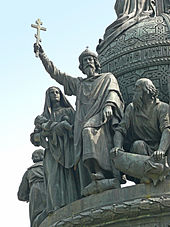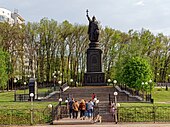Vladimir the Great
Vladimir I Sviatoslavich or Volodymyr I Sviatoslavych[8] (Old East Slavic: Володимѣръ Свѧтославичь, romanized: Volodiměr Svętoslavič;[a][b][10] Christian name: Basil;[11] c. 958 – 15 July 1015), given the epithet "the Great",[12] was Prince of Novgorod from 970 and Grand Prince of Kiev from 978 until his death in 1015.[13][14] The Eastern Orthodox Church canonised him as Saint Vladimir.[15][16]
"Prince Vladimir" redirects here. For the 2006 Russian film, see Prince Vladimir (film).Vladimir the Great
11 June 978 – 15 July 1015
970 – c. 988
Vysheslav
c. 958
Budnik[2] or Budiatychi[3]
15 July 1015 (aged approximately 57)
Berestove
- Allogia
- Rogneda of Polotsk
- Adela
- Malfrida
- Anna Porphyrogenita
Chalcedonian Christianity (from 988)
prev. Slavic pagan
c. 958
15 July 1015
15 July
Crown, cross, throne
Vladimir's father was Sviatoslav I of the Rurik dynasty.[17] After the death of his father in 972, Vladimir, who was then the prince of Novgorod, was forced to flee abroad after his brother Yaropolk murdered his other brother Oleg in 977 to become the sole ruler of Rus'. Vladimir assembled a Varangian army and returned to depose Yaropolk in 978.[18] By 980,[14] Vladimir had consolidated his realm to the Baltic Sea and solidified the frontiers against incursions of Bulgarians, Baltic tribes and Eastern nomads. Originally a follower of Slavic paganism, Vladimir converted to Christianity in 988,[19][20][21] and Christianized the Kievan Rus.[17][22]
Name[edit]
Several scholars refer to Vladimir as Volodimer,[23][24][25][26] also spelled Volodimir,[27][c] and his descendants as Volodimerovichi (sometimes in lieu of "Rurikids").[29][30] In the history of Scandinavia, Vladimir is also known as Valdemar or the Old Norse form Valdamarr (see Waldemar).[31][32][33][34]
Rise to power[edit]
Born in 958, Vladimir was the illegitimate and youngest son of Sviatoslav I of Kiev by his housekeeper Malusha.[35] Malusha is described in the Norse sagas as a prophetess who lived to the age of 100 and was brought from her cave to the palace to predict the future. Malusha's brother Dobrynya was Vladimir's tutor and most trusted advisor. Hagiographic tradition of dubious authenticity also connects his childhood with the name of his grandmother, Olga of Kiev, who was Christian and governed the capital during Sviatoslav's frequent military campaigns.[36]
Transferring his capital to Pereyaslavets, Sviatoslav designated Vladimir ruler of Novgorod the Great in 970,[13] but gave Kiev to his legitimate son Yaropolk. After Sviatoslav's death at the hands of the Pechenegs in 972, a fratricidal war erupted in 977 between Yaropolk and his younger brother Oleg, ruler of the Drevlians; Vladimir fled abroad and assembled a Varangian army to assist him in deposing Yaropolk.[37][18] On his return the next year, he marched against Yaropolk. On his way to Kiev he sent ambassadors to Rogvolod (Norse: Ragnvald), prince of Polotsk, to sue for the hand of his daughter Rogneda (Norse: Ragnhild). The high-born princess refused to affiance herself to the son of a bondswoman (and was betrothed to Yaropolk), so Vladimir attacked Polotsk, took Ragnhild by force, and put her parents to the sword.[35][38] Polotsk was a key fortress on the way to Kiev, and capturing Polotsk and Smolensk facilitated the taking of Kiev in 978, where he slew Yaropolk by treachery and was proclaimed knyaz of all Kievan Rus'.[39][14]
Years of pagan rule[edit]
Vladimir continued to expand his territories beyond his father's extensive domain. In 981, he seized the Cherven towns from the Duchy of Poland; in 981–982, he suppressed a Vyatichi rebellion; in 983, he subdued the Yatvingians; in 984, he conquered the Radimichs; and in 985, he conducted a military campaign against the Volga Bulgars,[40][41] planting numerous fortresses and colonies on his way.[35]
Although Christianity had spread in the region under Oleg's rule, Vladimir had remained a thoroughgoing pagan, taking eight hundred concubines (along with numerous wives) and erecting pagan statues and shrines to gods.[42]
He may have attempted to reform Slavic paganism in an attempt to identify himself with the various gods worshipped by his subjects. He built a pagan temple on a hill in Kiev dedicated to six gods: Perun—the god of thunder and war, a god favored by members of the prince's druzhina (military retinue); Slavic gods Stribog and Dazhd'bog; Mokosh—a goddess representing Mother Nature "worshipped by Finnish tribes"; Khors and Simargl, "both of which had Iranian origins, were included, probably to appeal to the Poliane".[43]
Open abuse of the deities that most people in Rus' revered triggered widespread indignation. A mob killed the Christian Fyodor and his son Ioann (later, after the overall Christianisation of Kievan Rus', people came to regard these two as the first Christian martyrs in Rus', and the Orthodox Church set a day to commemorate them, 25 July[44]). Immediately after the murder of Fyodor and Ioann, early medieval Rus' saw persecutions against Christians, many of whom escaped or concealed their belief.[d]
However, Prince Vladimir mused over the incident long after, and not least for political considerations. According to the early Slavic chronicle, the Tale of Bygone Years, which describes life in Kievan Rus' up to the year 1110, he sent his envoys throughout the world to assess first-hand the major religions of the time: Islam, Latin Christianity, Judaism, and Byzantine Christianity.[45] They were most impressed with their visit to Constantinople, saying, "We knew not whether we were in Heaven or on Earth ... We only know that God dwells there among the people, and their service is fairer than the ceremonies of other nations."[46]
Christian reign[edit]
Vladimir then formed a great council out of his boyars and set his twelve sons over his subject principalities.[35] According to the Primary Chronicle, he founded the city of Belgorod in 991. In 992, he went on a campaign against the Croats, most likely the White Croats that lived on the border of modern Ukraine. This campaign was cut short by the attacks of the Pechenegs on and around Kiev.[53]
In his later years he lived in relative peace with his other neighbors: Bolesław I of Poland, Stephen I of Hungary, and Andrikh the Czech (a shadowy figure mentioned in A Tale of the Bygone Years). After Anna's death, he married again, likely to a granddaughter of Otto the Great.
In 1014, his son Yaroslav the Wise stopped paying tribute. Vladimir decided to chastise the insolence of his son and began gathering troops against him. Vladimir fell ill, however, most likely of old age, and died at Berestove, near modern-day Kiev. The various parts of his dismembered body were distributed among his numerous sacred foundations and were venerated as relics.[35]
During his Christian reign, Vladimir lived the teachings of the Bible through acts of charity. He would hand out food and drink to the less fortunate, and made an effort to go out to the people who could not reach him. His work was based on the impulse to help one's neighbors by sharing the burden of carrying their cross.[54] He founded numerous churches, including the Desyatynna Tserkva (Church, or Cathedral, of the Tithes) (989), established schools, protected the poor and introduced ecclesiastical courts. He lived mostly at peace with his neighbors, the incursions of the Pechenegs alone disturbing his tranquility.[35]
He introduced the Byzantine law code into his territories following his conversion but reformed some of its harsher elements; he notably abolished capital punishment, along with judicial torture and mutilation.[55]
The fate of all Vladimir's daughters, whose number is around nine, is uncertain. His wives, concubines, and their children were as follows:
The Eastern Orthodox, Byzantine Rite Lutheran and Roman Catholic churches celebrate the feast day of St. Vladimir on 15/28 July.[62][63]
The town Volodymyr in north-western Ukraine was founded by Vladimir and is named after him.[64] The foundation of another town, Vladimir in Russia, is usually attributed to Vladimir Monomakh. However some researchers argue that it was also founded by Vladimir the Great.[65]
St Volodymyr's Cathedral, one of the largest cathedrals in Kyiv, is dedicated to Vladimir the Great, as was originally the Kyiv University. The Imperial Russian Order of St. Vladimir and Saint Vladimir's Orthodox Theological Seminary in the United States are also named after him.
The memory of Vladimir was also kept alive by innumerable Russian folk ballads and legends, which refer to him as Krasno Solnyshko (the Fair Sun, or the Red Sun; Красно Солнышко in Russian). The Varangian period of Eastern Slavic history ceases with Vladimir, and the Christian period begins.
The appropriation of Kievan Rus' as part of national history has also been a topic of contention in Ukrainophile vs. Russophile schools of historiography since the Soviet era.[66] Today, he is regarded as a symbol in Belarus, Russia and Ukraine.
All branches of the economy prospered under Vladimir.[67] He minted coins and regulated foreign affairs with other countries, such as trade, bringing in Greek wines, Baghdad spices, and Arabian horses for the markets of Kiev.






